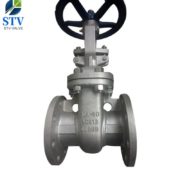What is the performance of the stainless steel gate valve?
Stainless steel gate valve performance:
Stainless steel gate valves are widely used in chemical, petrochemical, petroleum, paper, mining, electric power, liquefied petroleum gas, food, pharmaceutical, water supply and drainage, municipal, mechanical stainless steel valves, equipment supporting, electronics industry, urban construction and other fields. The valve is a control component in the pipeline fluid delivery system. It is used to change the passage section and the flow direction of the medium, and has the functions of diversion, cutoff, regulation, throttling, check, diversion or overflow relief. Valves for fluid control, from the simplest shut-off valves to the most complex self-control systems, are available in a wide variety of sizes and sizes. The nominal diameter of the valve ranges from very small instrument valves up to 10m. Valves for industrial piping. The valve can be used to control the flow of various types of fluids such as water, steam, oil, gas, mud, various corrosive media, liquid metal and radioactive fluid. The working pressure of the valve can be from 0.0013MPa to 1000MPa. From ultra-low temperature of -269 ° C to high temperature of 1430 ° C.
The opening and closing member of the stainless steel gate valve is a gate. The direction of movement of the gate is perpendicular to the direction of the fluid. The gate valve can only be fully open and fully closed, and cannot be adjusted and throttled. The gate has two sealing faces. The two sealing faces of the most common mode gate valves form a wedge shape. The wedge angle varies with the valve parameters, usually 50, and is 2°52′ when the medium temperature is not high. The gate of the wedge gate valve can be made into a whole, called a rigid gate; it can also be made into a gate that can produce a small amount of deformation to improve its processability and compensate for the deviation of the sealing surface angle during the machining process. Elastic shutter。



